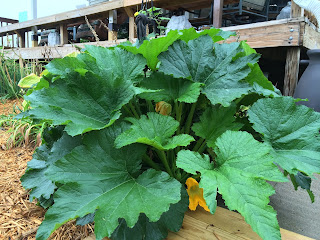 |
| August bounty |
Sunday, July 28, 2019
August sees the full production of the summer garden harvests. Late sweet corn (plant corn in succession and different varieties to lengthen the harvest), summer squashes (like zucchini and straightneck), peppers of all types (sweet to hot, hot), tomatoes, Mediterranean herbs, cucumbers, okra, apples, peaches, pears, grapes, beans, melons, figs, eggplant, honey, artichokes, blackberries, blueberries, raspberries, onion, tomatillos, and fennel are all in season right now.
A secret to maximizing your peppers, tomatoes, eggplants, tomatillos, and zucchinis is to harvest them continously. A plant’s driving force is to reproduce so by continuing to harvest, it causes the plant to put on more fruits. There are many options to preserve the extras: Freezing the extras for winter, drying Dehydrate or sun dry your extra veggies, canning Easy, low tox canning of summer's bounty, and pickling Make your own pickles without a store bought seasoning mix.
Continue to fertilize with a natural, organic fertilizer every month for veggies in the ground and semiweekly for those in containers. When fertilizing, scratch the fertilizer into the soil around the plant. If you leave the fertilizer on top of the ground, you will need twice as much as the nitrogen will off gas into the atmosphere if not covered. Summer garden tips
Keeping consistent moisture to your plants is key. Irregular watering causes tomatoes to crack. Make sure your garden is getting water weekly either from rain or watering, being sure to water deeply at the base of the plant and not on the leaves. Many warm weather lovers like squash, tomatoes and cucumbers are susceptible to fungal diseases.
If you had any lettuce from early planting, they will have bolted by now. Take the flower heads off and save the seed. You can shake the seeds into your self watering pots to get your fall lettuce growing. I have 3 different pots at 3 different stages of growth going right now to keep us in fresh salads.
Planting for fall and winter vegetables
I know it sounds crazy, but now is the time to start planting for fall and winter harvests. You need to plant early enough for your veggies to be full size when frosts hit. Add 14 days to the days to maturity listed on the seed packet and back it up from your last frost date. Time to plant for fall and winter harvests!
Daylight hours determine the growth rate of plants. Since the days are getting shorter, it will take longer for the plants to come to full maturity in the waning daylight hours of fall than the lengthening hours of spring. By the first of November, all growth has come to a full standstill until the beginning of January.
If you can't pick up transplants like broccoli, cabbage, lettuce, kale, and herbs at big box stores or a local nursery, you can get transplants from on line nurseries if you want to go that route. Farmers markets may also have them.
I have started doing more just from seed. I re-use 6 pack containers, put starting mix in them, water well, then add seeds, lightly covering per packet instructions. I just leave them on our covered deck in a tray so that I can keep them moist. Seeds sprout super fast this time of year. The other advantage is that they are already acclimated to the summer temps so do well when transplanted if grown outdoors.
Fall planting guide for cool season crops
August is the month for the rest of the greens (arugula, corn salad, lettuce, miner’s lettuce, spinach, mustard, endive), kohlrabi, onions, scallions, cabbage plants, radishes, peas, fava beans and turnips.
In September, plant more greens, carrots, and radishes. For our Zone 7a garden, the first 2 weeks of September are prime for planting lettuce. Try different cold hardy varieties planted at the same time. Different varieties mature at different times, giving you an on-going harvest.
October is the month to plant garlic for next year’s harvest. Time to plant garlic! With growing tips......
For more details on varieties to plant, Cold season crops for your edible garden
Caring for your new seeds and transplants
Like in the spring, newly sown seeds need moisture to sprout. Keep seeds and transplants moist until they get their first real set of leaves and are well established. Then water as needed.
Many crops you can harvest into December and beyond, depending on how cold fall is. Some get sweeter with some frost, like carrots, chard, and lettuce. With cover, you can harvest all the way through winter!
I bought a new, larger portable greenhouse this past winter and used it this past spring. It worked great! It is super lightweight and accommodates many plants. I can get 10 pots under its cover. It could also be placed directly in the garden as well. I'm going to use it to extend the fall and winter harvest for potted greens, broccoli and cabbage. Prepare for hard freeze
 |
| New, larger portable greenhouse |
A quick reminder, save the seeds from your best performers to plant next year! You can replant seeds from any heirlooms or open pollinated plants. Not only does it save you money, but it also gives you the plants that do the best under your garden and zone conditions.









